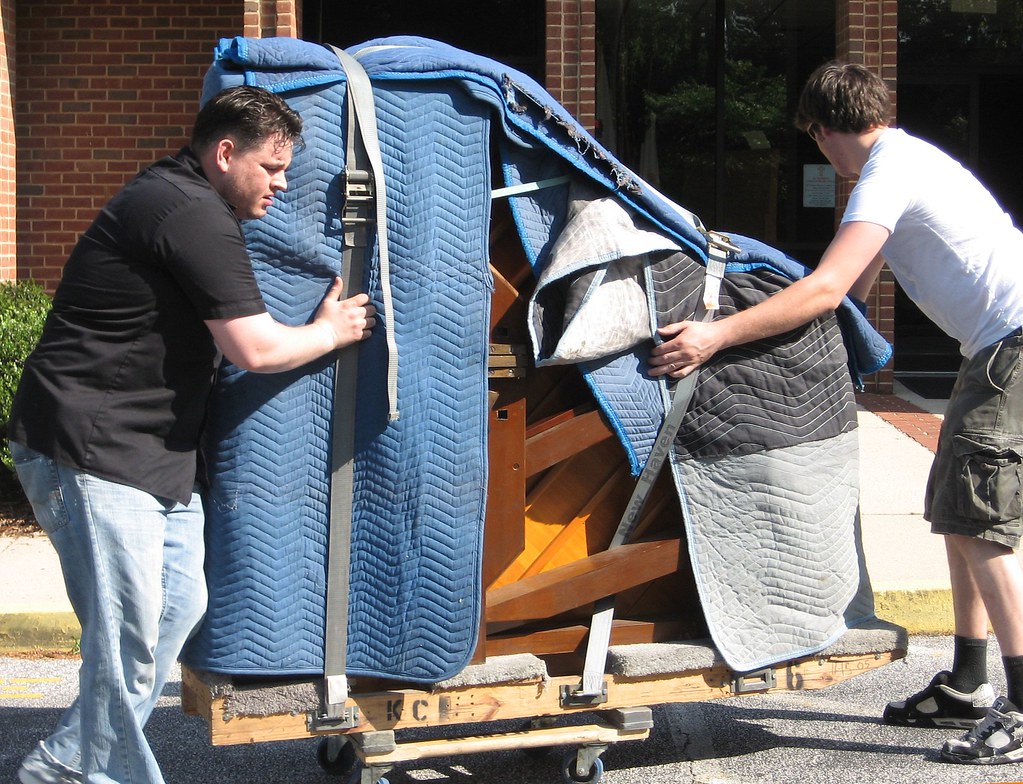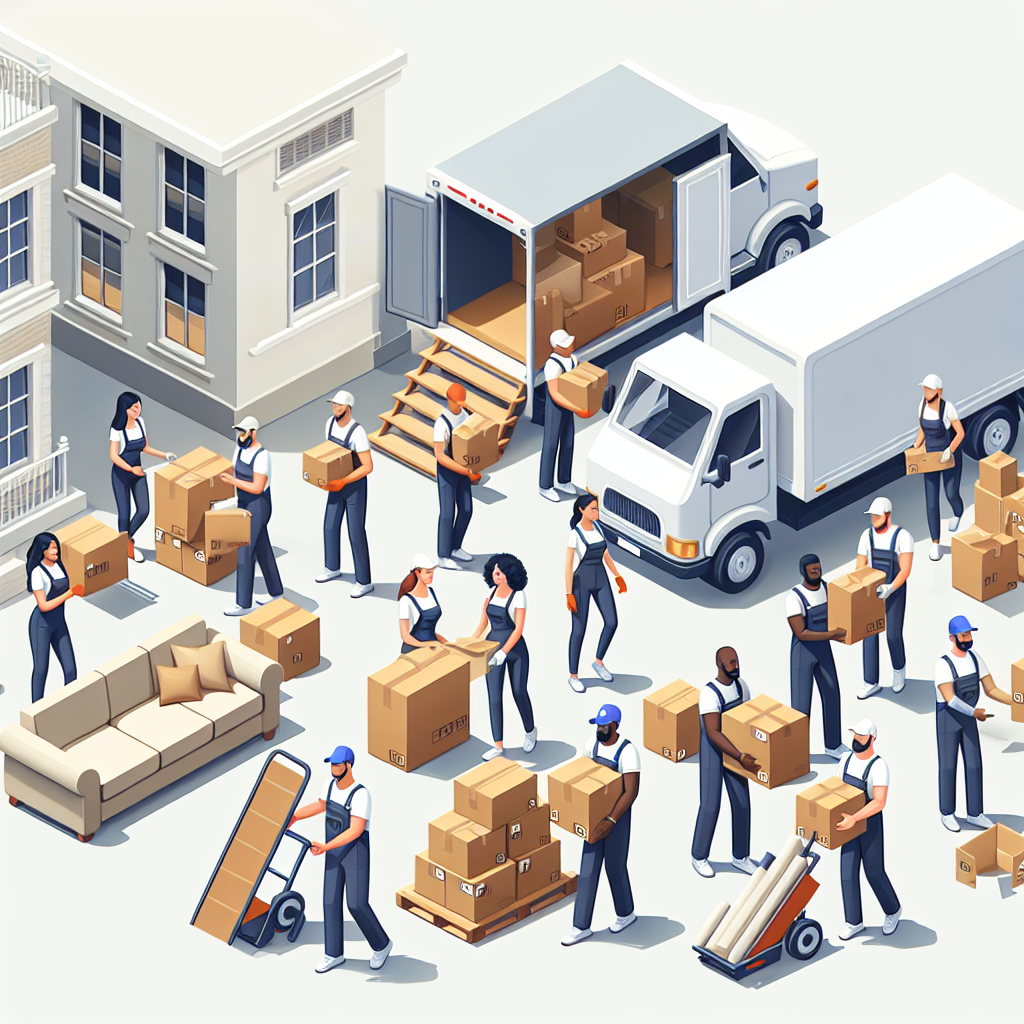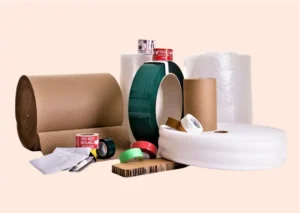Table of Contents

“Moving the Piano | jnshaumeyer | Flickr” from www.flickr.com and used with no modifications.
Picture this: a grand piano, gleaming under the spotlight, ready to fill the room with melody. But before the concert, there’s a challenge we must face – moving this majestic instrument. Whether it’s a delicate spinet or a grandiose grand, every piano deserves a safe journey to its new stage. Let’s dive into the art of piano moving and ensure your piano’s transition is as harmonious as its music.
Key Takeaways
-
Assess the size and type of your piano for precise planning.
-
Use specialized moving equipment to protect your instrument.
-
Follow proper lifting techniques to safeguard your back and the piano.
-
Consider the post-move tuning to keep your piano sounding perfect.
-
When in doubt, contact professional movers for their expertise.
Master the Basics of Piano Moving
Moving a piano isn’t just about getting from point A to B; it’s about understanding the instrument’s intricacies and respecting its craft. A piano isn’t just furniture; it’s a finely tuned marvel of engineering that requires a gentle touch and meticulous planning. So, let’s start by mastering the basics of piano moving to ensure a seamless transition.
Understanding Your Piano’s Unique Needs
Every piano has its own personality, dictated by its size, weight, and type. A grand piano, with its sprawling frame, demands different handling than an upright piano, which is more compact but still heavy. The key is to measure your piano’s dimensions, consider its weight, and plan the move with these factors in mind.
Preparation Strategies Before the Move
Before we even touch the piano, we need to prepare. This means clearing a path, securing loose parts like the music stand, and locking the keyboard lid. Remember, the goal is to prevent any movement within the piano that could cause damage. And don’t forget to protect your floors and doorways – the last thing we want is a scratch on either your piano or your home.

Tools of the Trade
Now, let’s gear up. Moving a piano isn’t a brute force job; it’s a technical one that requires the right tools. Here’s what we’ll need:
Essential Equipment for Safe Piano Transport
-
A piano dolly: To roll the piano safely across flat surfaces.
-
Protective blankets and padding: To shield the piano from bumps and scrapes.
-
Straps and harnesses: To secure the piano during the move.
-
Skid boards: For grand pianos, to maintain stability and distribute weight.
These tools aren’t just accessories; they’re necessities. Without them, we risk damaging not just the piano, but also our surroundings and ourselves. For more information on moving your piano with precision, visit Harmony in Transition: Moving Your Piano with Precision.
Selecting the Right Moving Aids for Your Piano Type
Different pianos call for different aids. For instance, a grand piano requires a skid board and straps for horizontal movement, while an upright piano is best moved with a dolly. Selecting the right aids is crucial to protect your piano’s structural integrity.
Securing the Piano for Movement
Securing the piano is like preparing a ship for a voyage across the high seas. It’s all about making sure everything stays in place, no matter the bumps along the way. First, we wrap the piano in protective blankets, ensuring every inch is covered. Then, we use straps to hug the blankets close to the piano’s body. It’s not just about protection—it’s about giving your piano a safe embrace.
Lifting Techniques to Protect Your Back and the Instrument
Lifting a piano isn’t a solo act—it’s a team effort. And like any team effort, coordination and technique are key. We always lift from the knees, keeping our backs straight, and we communicate every step of the way. It’s not just about avoiding injury; it’s about respecting the instrument by handling it with the care it deserves.
Most importantly, we never underestimate the weight of a piano. That’s why we use piano dollies and lifting straps to share the load, and we always ensure there’s enough hands on deck. Because, at the end of the day, it’s not just about moving an object—it’s about moving a piece of art.
Navigating Through Doors and Staircases
Navigating a piano through doors and staircases is like threading a needle with a thread made of solid wood and iron. We measure twice and move once, always mindful of the delicate dance between the piano and the architecture around it. We pad the edges, take our time, and sometimes, we even have to remove a door. It’s all in a day’s work to make sure the piano—and the home—stay unscathed.
Tuning and Post-Move Care
After the move, your piano will need a little TLC. Just like us, it can get out of tune after a big change. That’s why we recommend a professional tuning to bring back its perfect harmony. And let’s not forget about the acclimation period; your piano needs to get used to its new environment, just like you do. So, give it a couple of weeks to settle before that tuning.
But it’s not just about the strings. Check the piano’s exterior for any signs of the move, and if you spot something, don’t worry—most of the time, it’s nothing a little polish can’t fix. It’s these finishing touches that make all the difference, turning a house back into a home, with music at its heart.

Settling Your Piano at the New Location
When your piano arrives at its new location, don’t rush to push it against the wall and start playing. Let it sit. Let it breathe. And let it adjust to the temperature and humidity of its new environment. This is crucial for the wood and strings to stabilize and ensures the longevity and sound quality of your beloved instrument.
When to Tune Your Piano After the Move
Timing is everything, especially when it comes to piano tuning. Wait about two to four weeks after the move before you bring in a tuner. This gives your piano enough time to acclimate to its new surroundings. And when you do schedule that tuning, make sure it’s with a trusted professional who understands the nuances of your piano’s brand and model.
When to Call the Professionals
-
If your piano is particularly heavy or valuable.
-
When you’re moving to or from a home with multiple stories.
-
If the move involves complex navigation, like tight turns or narrow hallways.
-
When you simply want the peace of mind that comes with professional expertise.
There are times when calling in the professionals isn’t just a good idea—it’s essential. They have the experience, the equipment, and the insurance to ensure your piano’s move is smooth and stress-free. So, when in doubt, reach out to the experts and let them take the weight off your shoulders—literally.
If you’re feeling overwhelmed by the thought of moving your piano, remember, you’re not alone. There are professionals who do this day in and day out, and they’re just a click away. Don’t hesitate to contact us for help. We’re here to ensure your piano’s move is as flawless as its sound.
Piano Moving Success Stories: When Expertise Made the Difference
There’s nothing quite like hearing about a job well done, especially when it comes to something as delicate as moving a piano. Take, for example, the Steinway grand that had to navigate a spiral staircase. It seemed impossible, but with the right team and equipment, it was moved without a scratch. Stories like this are a testament to the skill and attention to detail that professional movers bring to the table.

How to Choose a Reliable Piano Moving Company
Choosing a reliable piano moving company is like finding a new teacher for your child—you want someone you can trust. Look for companies with years of experience, glowing testimonials, and the willingness to answer all your questions. And remember, the best movers will want to protect your piano as much as you do. So, choose someone who speaks the language of music as fluently as you do.
And there you have it, the ins and outs of piano moving mastery. From preparation to post-move care, it’s all about treating your piano with the respect and care it deserves. Whether you decide to tackle the move yourself or call in the professionals, remember the goal is always a harmonious transition. And if you ever need assistance or advice, we’re just a click away—contact us and let’s make beautiful music together.
There’s nothing quite like hearing about a job well done, especially when it comes to something as delicate as moving a piano. Take, for example, the Steinway grand that had to navigate a spiral staircase. It seemed impossible, but with the right team and equipment, it was moved without a scratch. Stories like this are a testament to the skill and attention to detail that professional movers bring to the table.
How to Choose a Reliable Piano Moving Company
Choosing a reliable piano moving company is like finding a new teacher for your child—you want someone you can trust. Look for companies with years of experience, glowing testimonials, and the willingness to answer all your questions. And remember, the best movers will want to protect your piano as much as you do. So, choose someone who speaks the language of music as fluently as you do.
FAQs
How Can I Tell if My Piano Is Too Heavy to Move Without Professional Help?
If you’re unsure about the weight of your piano and whether it’s safe to move it on your own, consider these factors: the type of piano (grand or upright), its size, and if you have the necessary manpower and tools. When in doubt, it’s always safer to consult with a professional moving company—they can provide an assessment and help you make an informed decision.
What Are the Risks of Moving a Piano Myself?
Moving a piano on your own comes with several risks, including potential injury to yourself or others, damage to the piano, and damage to your property. Pianos are not only heavy but also awkwardly shaped and delicate. Without the proper equipment and expertise, you could end up with a costly mistake.
How Long Should I Wait Before Tuning My Piano After a Move?
It’s recommended to wait two to four weeks before tuning your piano after a move. This waiting period allows your piano to acclimate to its new environment, particularly to changes in temperature and humidity. Tuning too soon may result in an inaccurate tuning that won’t hold as the piano continues to settle.
What Should I Do to Prepare My Piano Before the Movers Arrive?
Before the movers arrive, ensure that you have cleared a pathway for them to work, secured any loose parts on the piano, and locked the lid. It’s also helpful to notify the movers of any potential obstacles such as stairs, narrow doorways, or tight turns. The more information they have, the better prepared they will be.
Example: Mrs. Johnson prepared her baby grand piano for moving by carefully wrapping it in moving blankets and securing the blankets with tape. She also made sure to clear the path from her living room to the front door, removing rugs and furniture to prevent any tripping hazards.
Can I Move a Piano up or down Stairs on My Own?
Moving a piano up or down stairs on your own is highly risky. Pianos are extremely heavy and require special equipment and techniques to move safely. It’s always best to hire professional piano movers who have the experience and tools necessary to navigate stairs without causing damage to the piano or injury to themselves or others.
And there you have it, the ins and outs of piano moving mastery. From preparation to post-move care, it’s all about treating your piano with the respect and care it deserves. Whether you decide to tackle the move yourself or call in the professionals, remember the goal is always a harmonious transition. And if you ever need assistance or advice, we’re just a click away—contact us and let’s make beautiful music together.



